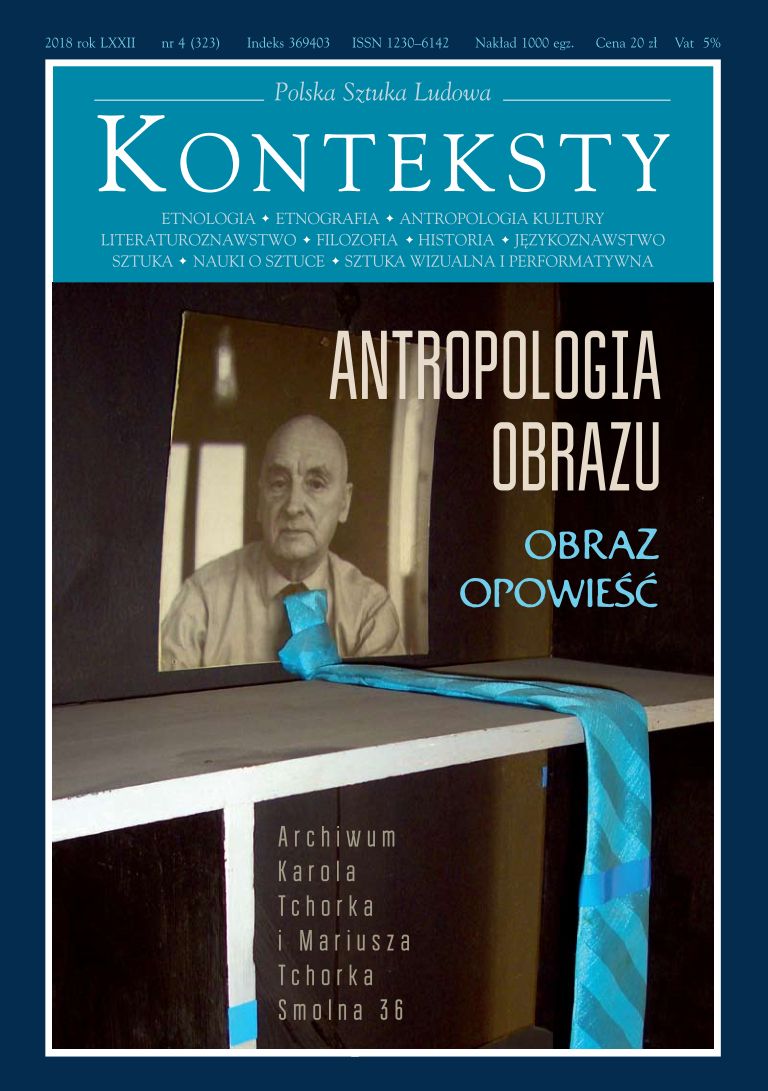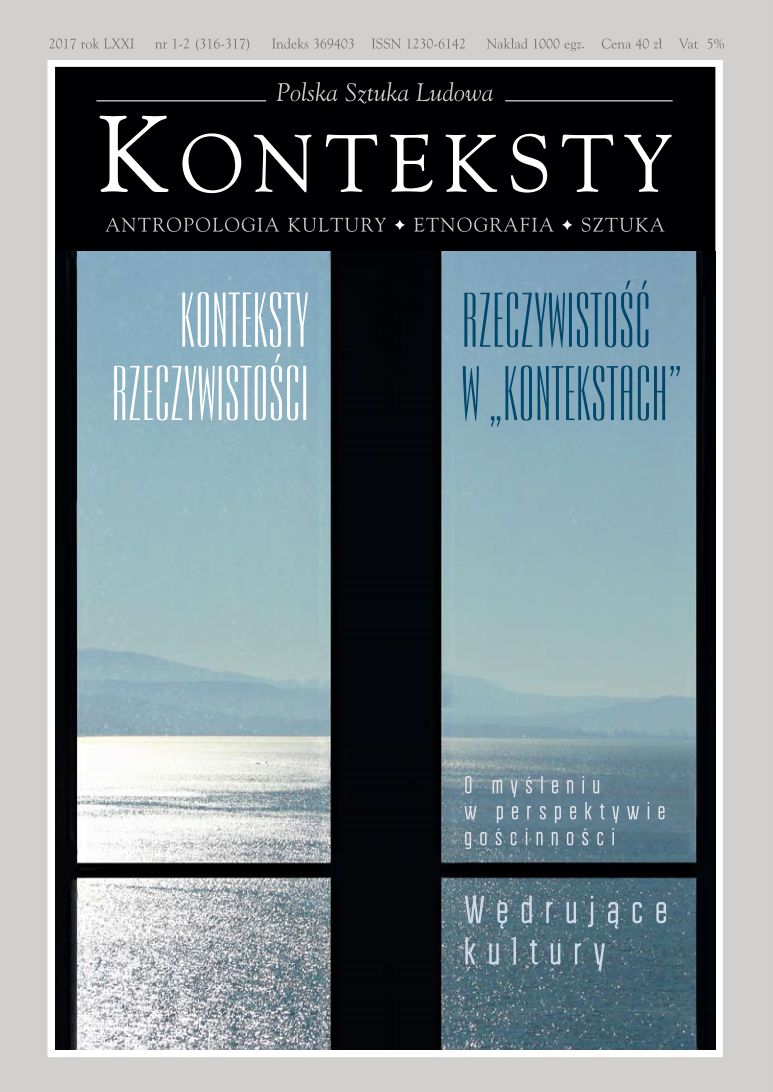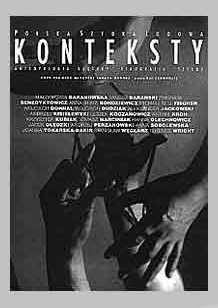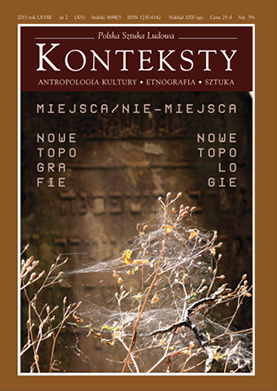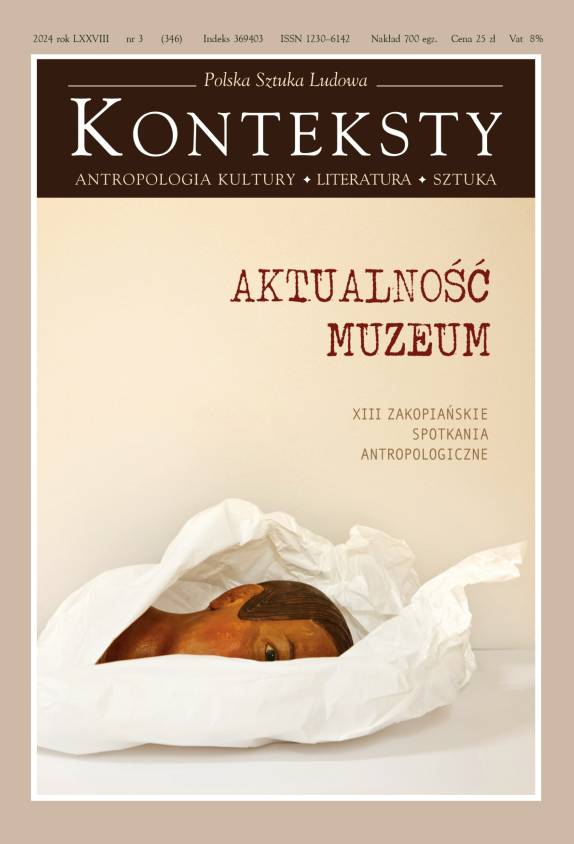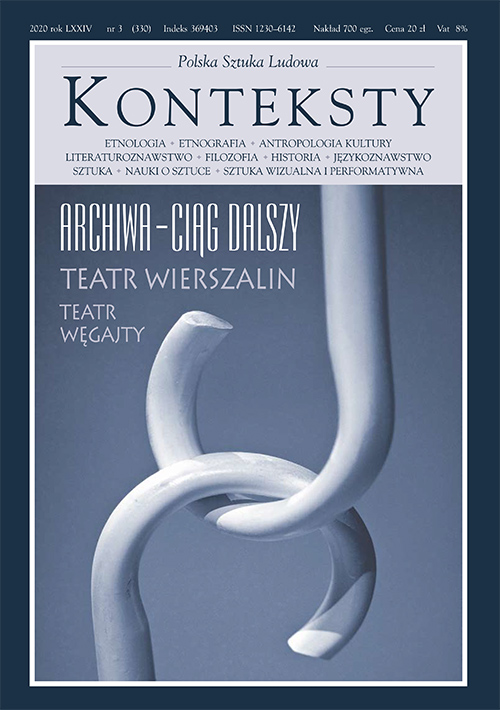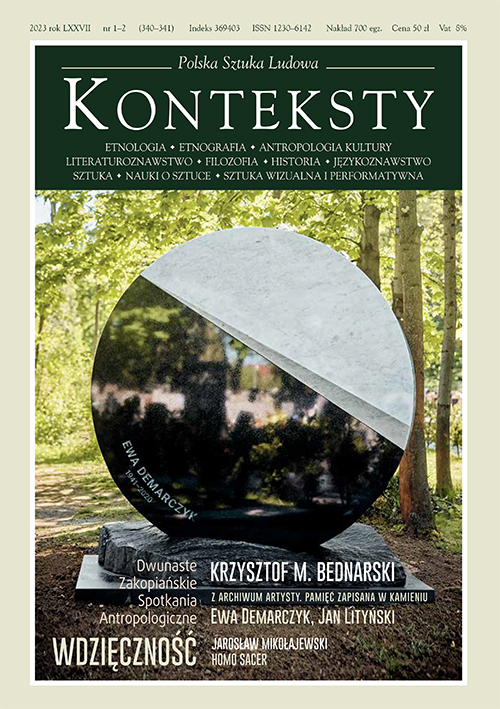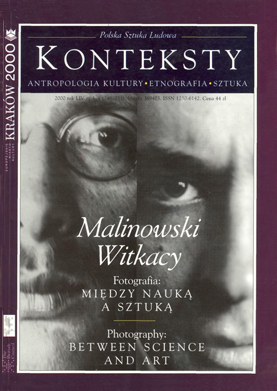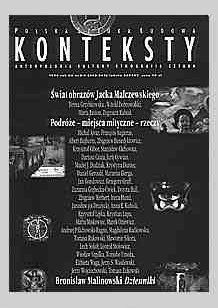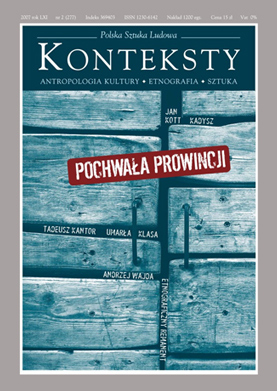Issue 2017/3 (318) - Mystery of the Gate - Anthropology of Memory

| Paweł Próchniak | In an Opening | 4 |
| *** | ||
| N. N. | Gate | 6 |
| N. N. | You’re in the Gate | 7 |
| Władysław Panas | Gate  | 9 |
This essay discusses thematic-aspect semiotics of Brama Grodzka (the Grodzka Gate) in Lublin. The author read and interpreted the “writing” of the space (real and symbolic) in whose very centre the Gate is located. The perspective of geo-poetics becomes connected with a sociological approach, while the topography of Lublin and the location and architectonic form of the Gate become a canvas for assorted presences of the symbolic tissues of reality, which, in turn, lead towards the profound structure of the “text” of Lublin. A prominent motif of the argument is an analysis of photographs of the Gate taken by Józef Czechowicz and reflection on the “place of the place” of the Gate and that, which becomes disclosed in its “opening”. | ||
| Władysław Panas | The Eye of the Tzaddik  | 15 |
A supplement of the essay Brama (The Gate) pertaining, first and foremost, to the semantic of the empty space left behind by the “Jewish town” in Lublin, and secondly, the meanings inscribed into the “text” of spatial structures (within the range of the organization of space and architecture), which in assorted ways ”fill” the emptiness. The author analysed and interpreted the town’s tissue (in particular the empty site of the former t parish church and the space where years ago the Seer of Lublin lived and worked), treating them as curious manifestations of non-existence and, at the same time, traces of the impact of radical evil. Those mutually permeating strata of meanings (topographic, symbolic, imaginary, and metaphysical) create a story emerging in an empty space – the trace of space (of silent emptiness), and fill it with the actual presence of “writing” and ensuing reading (a form of reading the world and a lesson of existence). | ||
| Paweł Próchniak | In the Eye of the Tzaddik a Contribution to the Topology of a Palimpsest  | 27 |
An attempt at a description and interpretation of a semiotic structure created in the manner of a palimpsest by mutually permeating texts whose keystone is the person of the Seer of Lublin and the town of Lublin as such. The potential of the meaning of this palimpsest – focused predominantly on the essay: Oko Cadyka (The Eye of the Tzaddik) by Władysław Panas – is the prime object and canvas of reflections about Lublin, presented in the sketch and conceived as a semiotic continuum spanning from a concrete place in the town’s topography to areas indicated by the mystic intuitions of the Seer. | ||
| N. N. | A Boy from Kamionka | 33 |
| Conversations | ||
| Marcin Skrzypek | Deliberate Incident – conversation with Tomasz Pietrasiewicz | 37 |
| Tomasz Cyz | Performance from Memory – conversation with Tomasz Pietrasiewicz | 52 |
| Paweł Próchniak | Nighttime Theatre – conversation with Tomasz Pietrasiewicz | 56 |
| Theatre | ||
| Elżbieta Wolicka | In Praise of Privacy. Comments on the Intimate Form of the NN Theatre  | 64 |
This sketch is an aspect-oriented presentation of Wędrowki niebieskie (Blue Wanderings) – the first spectacle staged at Teatr NN (the NN Theatre), written and directed by Tomasz Pietrasiewicz in 1990. The author drew attention to the genetic connection between the theatrical matter of the production and the literary works, which create the textual stratum. She also pointed out a striving, revealed in the spectacle, towards building on stage an “intimate form”. By referring to the tradition of the “poor theatre” and “private art”, this form is contrasted with the “spectacle” form of a theatre created “with the public in mind” (i.e. vying for success) and becomes a canvas of a theatrical event offering an opportunity for participating in “essential conversation”. | ||
| Elżbieta Wolicka | Invocation. A Spectacle at the NN Theatre  | 67 |
Inwokacja (Invocation) is the third spectacle staged at the NN Theatre (1992), discussed against the backdrop of earlier productions created and directed by Tomasz Pietrasiewicz. The author of the article indicated the essential part played by the textual stratum of the spectacle, but also considered and interpreted its visual side and auditory dimension connected with the presence of a “choir” and music (psalms by Jan Gomułka and religious songs by Wacław z Szamotuł, all performed on stage). The sketch formulates a thesis about the crystallization in Inwokacja of an “intimate poetic”, so characteristic for the Pietrasiewicz theatre (and based on operating with “poor” measures), which produces an “intimate melopoeia” and not only steers the visual imagination of the spectator but also focuses his hearing on emotional “vibrations” that create values. | ||
| Jan P. Hudzik | Two Spectacles at the NN Theatre Remarks on „Wędrówki niebieskie” and „Ziemskie pokarmy”  | 69 |
A presentation of two earliest spectacles shown by the NN Theatre – both written and directed by Tomasz Pietrasiewicz (1990 and 1991). The analyses indicate that the theatrical reality construed on stage is a form of an inner landscape, which discloses space “suffused with values” and, at the same time, poses fundamental questions about the nature of the world and human condition as well as the sources and meaning of art. Artistic introspection – whose figure is wandering – leads towards problems connected with the artist’s identity, relations between solitude and art, and the status of actual reality perceived through the prism of creativity envisaged as an act of inner freedom and a supreme form of existence. Seen from this viewpoint, the debut spectacle shown at the NN Theatre (Wędrówki niebieskie) is a study on artistic imagination. The next spectacle (Ziemskie pokarmy) comprises, first and foremost, reflections on the essence of “the theatrical”. In both cases we deal with a conviction that art – similarly to life – consists of endless wandering, a search for “the signs of meaning”. | ||
| The City of Poetry | ||
| Paweł Próchniak | City of Poetry: Locatio  | 73 |
Both sketches indicate assorted aspects of perceiving an actual place as a metaphor. In this particular case we are dealing with Lublin, together with its spatial configuration and history as well as all that, which creates the town’s potential, both as regards meaning and imagination. At the same time, the two texts depict the premises and ambitions of the “City of Poetry” project, since 2007 realized in Lublin by the “Grodzka Gate – NN Theatre” Centre. | ||
| Paweł Próchniak | City of Poetry: Place of the Metaphor Added Years Later  | 77 |
Both sketches indicate assorted aspects of perceiving an actual place as a metaphor. In this particular case we are dealing with Lublin, together with its spatial configuration and history as well as all that, which creates the town’s potential, both as regards meaning and imagination. At the same time, the two texts depict the premises and ambitions of the “City of Poetry” project, since 2007 realized in Lublin by the “Grodzka Gate – NN Theatre” Centre. | ||
| Iwona Chmielewska | As Long as the Sky Doesn’t Cry | 80 |
| Abram Zylberberg, Józef Czechowicz, Iwona Chmielewska | Lullaby | 80 |
| Abram Zylberberg, Józef Czechowicz, Iwona Chmielewska | Dancing Leaves Sing | 81 |
| Abram Zylberberg, Józef Czechowicz, Iwona Chmielewska | Hay-making | 81 |
| Jacek Podsiadło | Eyes of Eyes | 82 |
| Recognitions | ||
| Joanna Zętar | Grodzka Gate. Biography of a Place  | 83 |
The author considered the history of Grodzka Gate in Lublin – from the very first mention of this building, which dates from the early fourteenth century, to the present day. An extensive historical panorama is supplemented by fragments of guidebooks to Lublin and witness accounts concerning the Gate during the pre-Second World War period. A description of the site’s history also takes into account the activity of the “Grodzka Gate – NN Theatre” Centre situated in the titular building. | ||
| Grzegorz Józefczuk | Intimate Contacts with the Absent  | 99 |
A presentation of the “Grodzka Gate – NN Theatre” Centre and its founder and head: Tomasz Pietrasiewicz, portrayed against the wide historical-cultural background of Lublin, a town whose postwar identity up to the 1980s remained ideological and connected with the Polish Committee of National Liberation – the foundation myth of People’s Poland. This image gradually changed in favor of totally different narrations devised by cultural-academic elites and contesters originating from the alterative theatre. The creation of those transformations emphasized the town’s multi-cultural (i.a. Jewish) heritage, its current status of a “borderland”, the participation of Lublin in formulating free speech practices (i.a. an independent publishing movement), as well as the town’s myth-creating potential. The author indicated that the “Grodzka Gate – NN Theatre” Centre directed by Pietrasiewicz plays a pioneering and creative part in such metamorphoses as well as their documentation and interpretation. | ||
| Izabela Skórzyńska | There Is No Way Out... On the Memory Theatre at the NN Theatre  | 113 |
This article is an in-depth presentation of the undertakings of Tomasz Pietrasiewicz and the “Grodzka Gate – NN Theatre” Centre involving “work with memory”. An extensive panorama of the assorted ventures pursued by the Centre (spanning from artistic to social) is depicted against a wide and well-identified background of questions associated with animating and sustaining memory. The author presented the crucial versions of the “memory theatre at the NN Theatre” (such as the The Mystery of Memory, Listy do Henia [Letters to Henio], or the Memory Trail: Lublin. Pamięć Zagłady [Lublin. Memory of the Holocaust]), arranged in chronological order and subsequently analysed and subjected to reinterpretation. In doing so she also treated their premises, inner structure, and impact as a problem, at the same time demonstrating that they can be perceived as a cohesive artistic undertaking (with a theatrical provenance) developing in time and comprising a form of, primo, assuming responsibility for “abandoned memory” and, secondo, its re-introduction into the actual and imaginary-symbolic space of Lublin. | ||
| Anna Ziębińska-Witek | Towards a Counter-Monument. The Commemoration of Lublin. Memory of the Holocaust  | 129 |
A description of Tomasz Pietrasiewicz’s commemoration of the Lublin Umschlagplatz. The installation: Nie/Pamięć Miejsca (The Non/Memory of the Place), together with a memory trail, completes and supplements earlier projects proposed by the NN Theatre, which in urban space create a strong symbolic structure supporting and reinforcing the difficult process of restoring the memory, for years ejected, of the Jewish inhabitants of Lublin. A community defines itself through monuments and its reaction towards the past. Commemorations – envisaged as visualizations of group memory – represent the reality of the past, discuss the latter within a social context as the social and individual experiences of contemporary authors, and, first and foremost, do not allow it to vanish from human awareness. The installation: Nie/Pamięc Miejsca additionally constitutes a special site, since it experiments with the form of the message and leads towards a self-aware and self-reflective counter-monument. | ||
| Katarzyna Kuczyńska-Koschany, Anita Jarzyna | Visiting the Crime Scene  | 134 |
A multi-content interpretation of a poem by Piotr Mitzner: Dom Słów (House of Words), from the volume: Polak Mały (A Polish Child, 2016), dedicated to Tomasz Pietrasiewicz – founder and director of the “Grodzka Gate – NN Theatre” Centre. As interpreted by the authors of the article Mitzner’s poem fills a poetic gap in narrations about the activity of the Centre and its seats, in particular the more recent one – Dom Słów (House of Words, in Żmigród Street) and in a specific way – i.e. by resorting to poetic abbreviation – condenses the mission fulfilled by Lublin institutions involved in regaining memory about the town’s Jewish residents. Mitzner described a place where during the inter-war period the foundations of both cultures were reinforced both literally and metaphorically, and which was the site of print shops; today, the “Grodzka Gate – NN Theatre” Centre brings us closer to the history and arcana of the art of printing and the book as well as the history of an independent publishing movement in 1976–1989, topics on which the House of Words concentrates its diverse educational activity. The Warsaw-based poet wrote predominantly about the force of the word, capable of realigning a shattered world. The title of the sketch also refers to becoming re-acquainted with the site a catastrophe – the Holocaust of the Lublin Jews. | ||
| Radosław Bomba | Lublin 2.0. Animation of Digital Culture in the Activity of the “Grodzka Gate – NN Theatre” Centre  | 141 |
The article concerns the functioning of the “Grodzka Gate – NN Theatre” Centre within digital culture. As a relatively young institution the Centre has in the course of its activity delineated new trends and strategies of the animation of culture by resorting to digital media. The author portrayed the numerous new-media projects conducted by the institution in question within the context of the prime transformations to which web and digital media have been subjected in recent years. Such transformations involve primarily the establishment of social networks and an unprecedented growth of participatory culture (known as “Culture 2.0”), but also the phenomenon of augmented reality and the post-media. A thus outlined backdrop of the “digital revolution” shows distinctly the innovativeness and creativity of the initiatives and undertakings pursued by the Centre, exploring multi-aspect relations between digital technologies and culture. | ||
| Paweł Krysiak | Attacks Against the Gate  | 149 |
A discussion and an analysis of activity motivated by hatred and aimed against Tomasz Pietrasiewicz and the “Grodzka Gate – NN Theatre” Centre, which he directs. Within this campaign both the seat of the Centre (a site commemorating the exterminated Jews of Lublin) and Pietrasiewicz’s flat became the target of attacks launched by anti-Semites. Initially, the investigative authorities down-played the incidents, an attitude that resulted in an organized anti-Semitic poster campaign conducted across Lublin. The specific climate of consent accompanying those occurrences stirred the indignation of numerous NGOs (including Amnesty International) defending human rights, which demanded a determined reaction on part of the authorities. years later, the perpetrators of the anti-Semitic campaign were ultimately apprehended and tried. The presented animosities directed against Pietrasiewicz and the Gate (as well as a reconstruction of the associated sequence of events and the accompanying atmosphere) suggest a thesis about the revival of fascism in Lublin and the silent acquiescence of many local residents. | ||
| Flashes | ||
| Aleksander Jackowski | Lublin. The “Grodzka Gate – NN Theatre” Centre  | 156 |
This sketch discusses the most prominent and chronologically arranged stages in the activity of Tomasz Pietrasiewicz – both theatrical and the one conducted within the “Grodzka Gate – NN Theatre” Centre. An outlined history of those undertakings makes it possible to demonstrate the way in which successive versions of the Theatre – an outcome of the contesting tradition of “alternative art” – became, due to inner transformations, an institution whose dimension – not merely artistic but also social – created space in which “the call for memory” and tackling memory become an act of an “affirmation” of that, which demands to be salvaged in human reality despite the fact that it is unwanted and rejected. In this fashion, and without losing its edge, “contestation” turns against oblivion and contempt. | ||
| Alfred Wierzbicki | In the Grodzka Gate | 159 |
| Henry Foy | The Lost Faces of Lublin  | 161 |
An essay discussing the most significant accomplishments of Tomasz Pietrasiewicz concerning the memory of the annihilated Jewish community of pre-war Lublin. The author outlined an in-depth portrait of Pietrasiewicz as an artist who not only stood up for memory but also decided to wage a battle against the foundation of “dark utopia”, i.e. the Holocaust, which was not limited to a methodically conducted physical extermination but aimed at a total destruction of all traces of the annihilated Jews. The struggle proposed by Pietrasiewicz assumed the form of building a “light utopia”, i.e. an attempt at salvaging every trace of the existence of the exterminated residents of the “Jewish town” in Lublin. | ||
| Piotr Mitzner | In the Gate  | 169 |
A subjective panorama of the work performed by Tomasz Pietrasiewicz and the “Grodzka Gate – NN Theatre” Centre directed by him. The author emphasized the fact that this activity was embedded in the freedom of speech (and recalled that Pietrasiewicz co-created the underground publishing movement of the 1980s, a fact that years later resulted in the establishment of Dom Słów [The House of Words]); attention is also drawn to the “theatrical” component of the ventures pursued by Pietrasiewicz (including those that have become part of the town’s very tissue, such as Latarnia Pamięci [Memory Lantern]); finally, P. Mitzner accentuated the importance of assorted “documentation” initiatives and their underlying respect for the past, especially the one threatened with oblivion. The poetic applied in the sketch (“memory flashes”) stresses the fact that the most significant domain of Pietrasiewicz’s activity is delineated by criss-crossing vectors of memory and oblivion, with creative imagination, which learns a lot from poetry, being the tool of his work. | ||
| Piotr Mitzner | House of Words | 170 |
| Leora Tec | In the Centre  | 171 |
The story of an encounter with the phenomenon of the “Grodzka Gate – NN Theatre” Centre. The author of the essay indicates – upon the examples of concrete acts and situations – such symptoms and aspects of the work involving memory, and conducted by the Centre, which evade analytical or systematisation interpretations. The process of accepting personal viewpoints and concentrating on the effects of a sui generis “participating observation” makes it feasible to take a look at the “Gate people” and their daily efforts, which, as the sketch shows, far surpass the duties of employees. At the same time, the presented essay is an introspective study of a single case, which demonstrates that via an encounter with the “Gate people” the author regained a significant fragment of her personal identity. | ||
| Grażyna Lutosławska | On the Borderline  | 176 |
A sketch showing that the diverse and years-long activity pursued by Tomasz Pietrasiewicz and the “Grodzka Gate – NN Theatre” Centre constitutes a multi-motif entity whose value lies not only in a concentric movement associated with the creation of an “Ark of Memory”, but also a centrifugal force of inspiration. The author recalled that it was the Centre, cooperating with Władysław Panas, that initiated the work of Polish intellectuals and representatives of the arts aimed at restoring the memory of Bruno Schulz to the town of Drohobycz; by creating instruments intended for dealing with the abandoned memory of the exterminated residents of the “Jewish town” in Lublin it initiated and inspired an actual work with memory, involving its existential, social, and artistic dimensions. | ||
| Karol Maliszewski | N.N. | 180 |
| Materials | ||
| Krzysztof Janus | A Photographer from an Attic. A Collection of Glass Negatives Discovered in a House in 4 Market Square in Lublin an Attempt at a Synthesis of the Findings  | 181 |
An assortment of findings – subsequently put into order – up to now made in connection with the discovery in Lublin (2012) of a collection of almost 3 000 glass negatives by an unidentified author; the majority of the negatives, originating prior to the outbreak of the Second World War, portray the Jewish community in Lublin and the town’s environs. The author of the article discussed the circumstances of the discovery and the course of the conservation; he also analysed material found alongside the negatives, and indicated – with a great dose of probability – the author of the negatives. This is the first attempt at a synthesis of information gathered by different persons and institutions. | ||
| In the Clearing | ||
| N. N. | 190 | |
| N. N. | Nomen Nescio | 191 |
| Julia Hartwig | Friends | 193 |
| Others | ||
| Maria Prussak | What Do the Autographs of „Romantyczność” Tell Us?  | 194 |
Traditional textology treats the autographs of a given work as variants of the ultimate text published by a poet and distinguishes it from the larger entities in which they were sometimes written. As a rule, commentaries to the text do not draw attention to annotations in another handwriting. Romantyczność by Adam Mickiewicz – a literary and world outlook manifesto of the young generation – exists in two manuscript versions, one of which features distinct editorial conceptions recorded by the author’s associates from the Philomath Society. If one were to treat the manuscript differently, it would be possible to recognise that it is an example of joint work on a poem, which Mickiewicz subsequently published in another form in a debut collection. | ||
| Paweł Dybel | Poetic Games with Death. On the Poetry of Stanisław Czerniak  | 199 |
In recent years collections of poetry by Stanisław Czerniak: Nagie Że, Niagara and Iskra buntu have made a distinct imprint against the backdrop of Polish contemporary poetry. Their author devised a specific tone of philosophical lyric poetry, which involves a poetic approach to assorted metaphysical questions. The presented essay discusses the manner in which classical philosophical topoi applied in the poems, i.a. thanks to the introduction of sophisticated games with words, gain a new meaning. At the same time, this is lyric poetry suffused with profound scepticism and irony, albeit one that does not shy from evoking humorous effects and wit. A particularly interesting and novel solution deals with the questions of aging and death, at times startling in their directness and biological literalness. Czerniak attempts to conduct various games with death while maintaining an ironic distance. In his essay P. Dybel endeavoured to identify and describe the different poetic forms of those “games” by proposing a personal interpretation of the examined lyric poetry. | ||
| Anna Bistroń | Golden Jerusalem? A Stroll in Search of Holiness  | 206 |
This essay contains reflections from the borderland of several disciplines, with anthropology acting as their keystone. In the course of an imaginary “stroll” across Jerusalem the author tours prominent sites of the Holy City and discovers its assorted aspects associated with three monotheistic religions embroiled – in the name of the same God – in an endless clash, whose outcome is a departure from the very essence of religion, i.e. the sacrum. The quintessence of the uniqueness of this town appears to be not so much its “holiness” as a metaphorical translatability of the phenomena taking place there into the condition of the contemporary world (control; conflict; the Debordian spectacle supplanting spirituality; an awareness of disintegration; superficiality; lack of cohesion, etc.). In the interpretation suggested by the author, while discovering the space of Jerusalem we experience it not so much via architectural allure but through various associations: predominantly Biblical but also – or perhaps primarily – connected with theories proposed by Rudolf Otto, Guy Debord, Michel Foucault, Michel de Certeau, Jan Assmann… | ||
| Marta Ziętkiewicz, Gil Pasternak | The Subversive Power of Private Photograph Collections. The Jews in Polish Collective Memory after the Fall of Communism  | 213 |
In 1994 the Jewish-Polish Shalom Foundation announced a photographic contest whose intention was to reconstruct the social and cultural histories of Polish Jews who lived in the geographical region of Poland before, during and after the Second World War. For this purpose the Foundation invited contributions from the public. Its initiative emerged shortly after the 1989 collapse of the communist regime in Poland, and alongside other similar projects that reflected the desire of Poland’s ethnic minorities to salvage their sociocultural histories – histories the communist government had virtually erased from the county’s formal historiography. In a short period of time the Foundation received more than seven thousand annotated photographs in response to its public appeal, most of which emanated from domestic photographic collections. As scholars interrogating domestic photography do not often have access to empirical data about the practices it entails, in this article we consider the Foundation photographic collection as a resource preserving invaluable information about the diverse uses and perceptions of photography in the sociocultural sphere. Yet, whereas existing scholarly literature in the field of photography studies tends to frame domestic photography with reference to affectionate familial behaviors allegedly common in democratic states, we introduce the Foundation collection as a case study that sheds light on domestic photographs created and maintained in a sociocultural environment that did not see democracy before 1989. Analyzing and discussing the various ways in which the photographs’ owners saw the photographs’ relationships with the broader politically unstable reality that has enclosed their production and preservation, our study diversifies some of the meanings and functions current literature often associates with domestic photographic collections | ||
| Joanna Stacewicz-Podlipska | “There the Spirit of Volhynia Will Speak to Me?”. The Political Setting of the Volhynian Fair Held in Równe in 1934  | 225 |
The Fifth Volhynian Fair was organised in Równe in 1934, i.e. in conditions of a radicalisation of the prevailing social mood and a decline in support for the large-scale political project realised in Volhynia by voivode Henryk Józewski. The project, known as the Volhynian experiment, assumed the possibility of retaining the specific social structure of Volhynia, within which the Ukrainian-Polish-Jewish genius loci of the region would be protected. This “trial programme” of sorts was to serve as a matrix for the Polish policy towards the national minorities. Its success was decisive for the future of a number of correlated activities, which foresaw within the so-called Promethean programme the exploitation and steering of pro-independence tendencies within the USSR for the sake of waging a struggle against international communism. In 1934, when the vitality and political forces of Józef Piłsudski, the patron and protector of Józewski, conspicuously deteriorated and the Volhynian experiment was becoming increasingly inconvenient for the Organisation of Ukrainian Nationalists, the voivode faced the threat of losing the mandate of both sides – Polish and Ukrainian. In this situation, the Fifth Volhynian Fair was turned into a representative platform resounding with praise for his policies and proving to be a powerful propaganda volley. Józewski was supported by an “art-decoration commission” composed of Teresa Roszkowska and Aleksander Jędrzejewski, who designed a setting that, according to their concept, accentuated the historical cohesion of the region. Thanks to words, gestures, and images, the Fifth Volhynian Fair was to become a performative structure transforming the socio-political reality of Volhynia according to a lucidly profiled vision of the Eastern Borderlands. | ||
| Patrycja Trzeszczyńska | Words at the End of the World: a Story about the Bieszczady Mts.  | 238 |
A text about the phenomenon of the Bieszczady belles letters, which emerged in the course of the past decade. These works comprise an affirmation of life in the Bieszczady Mts. seen through the personal perspective and experiences of the authors, who even when reaching for fictionalisation remain documentalists of the Bieszczady lifestyle and create an image of the region. An acquaintance with this prose, written both in the spirit of the imagery and myths about this distant part of Poland (i.a. the myth of a land of mellowness, the pioneer-cowboy myth, the myth of an uninhabited wilderness, the multicultural myth) and countering both approaches, demonstrates the operations involved in constructing the Bieszczady self-presentation and rendering indelible regional specificity in such a manner so that the reader rejects all associations with fiction. The author pondered on the status of the literary work as seen by an anthropologist and proposed reflecting on anthropological methods of analysing literature – the product of culture of interest to him. In doing so she advised approaching written narration perceived as cultural praxis and a form of activity. The Bieszczady example illustrates the purposes of the literary text, the way in which it assists the interpretation of the context and aids the cognitive process in those cases when we are particularly interested in self-presentation practices and narrations about the past, i.e. the way people portray themselves and what they want to say about themselves to others, not only to anthropologists. | ||





















